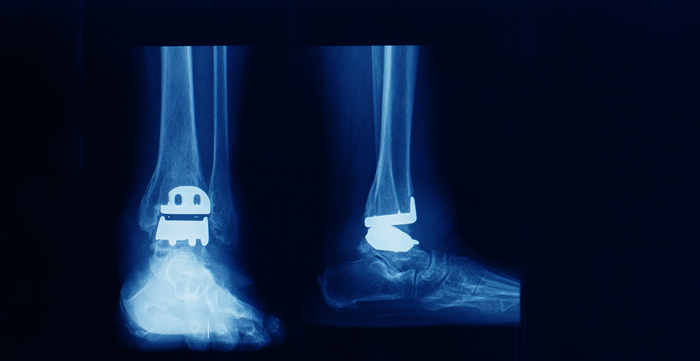Best Ankle joint replacement Treatment & Diagnostics in Chunni Ganj, Kanpur
Ankle joint replacement surgery is a surgery performed at Apollo Spectra, Kanpur, to replace the destroyed joint or a joint with abnormalities to an artificial new joint. The artificial joint for ankle joint replacement is made of plastic or metal.
Ankle joint replacement is common with thousands of surgeons performing ankle joint replacement each year.

How is the surgery performed?
At Apollo Spectra, Kanpur, X-rays and some tests are done to diagnose the disorder. The patient is then admitted to the hospital on the same day of the surgery. The surgeon gives general anesthesia for numbness and preventing pain during the surgery.
Once the general anesthesia is given, the surgeon makes small incisions in the front of the ankle and removes the destroyed joint from the ankle. The surgery is performed by using some specific instruments. Once the destroyed joint is removed, the surgeon places the new artificial joint into the ankle in place of the old destroyed joint. And the surgeon closes the incisions with the stitches and dresses the wound with a plastic splint.
Request an appointment at Apollo Spectra Hospitals, Kanpur
Call 1860-500-2244 to book an appointment
Side effects and risks of ankle joint replacement surgery
Being a surgical procedure, ankle joint replacement surgery comes along with its risks or side effects that should be looked upon before the surgery. Some of the possible complications of ankle joint replacement surgery are:
- Dislocation of joint by the surgeon during the surgery
- Experiences of stiffness or pain in the hand
- Risk of infections
- Formation of blood clots or occurrence of bleeding
- Injury in the nerves may occur
- Possibility of swelling in the fingers
- Loosening of joints may occur over time
- Medicines may cause allergic reactions sometimes
- Weakness or instability in the ankle
- Damages may be caused to the blood vessel
- Irritation in the skin after surgery
Before the surgery
The surgeon may recommend following some instructions at least 2 weeks before the surgery such as quitting alcohol and avoid smoking. It is important to discuss the medical history along with all the medications being taken in the present with the surgeon to avoid any further complications.
If the patient is being treated for any other disease such as diabetes or heart disease, then the surgeon must be made aware in advance of the same. The surgeon will ask to not eat anything 6 to 8 hours before the surgery. Physical therapy may also begin before the surgery in some cases, and the therapist may advise some exercises before the surgery.
After the surgery
The ankle of the patient will be dressed with a plastic splint. Local anesthesia may be given after the surgery to the patient for preventing pain in the hand. It is advised to keep the level of the ankle higher than the level of the heart to prevent swelling. In most cases, swelling or stiffness is experienced by the patients; it can be prevented by keeping the level of the hand above the level of the heart at least for the first 48 hours.
The therapist may advise further for practicing certain exercises and the dressing will be initially removed after 2 to 3 days. After the two weeks of the surgery, the surgeon may remove the stitches and the patient may get able to follow their day to day activity but the swelling may take 3 to 6 months for settling completely
Right candidates
It is important to overview the eligibility criteria before the surgery for avoiding any further risks and complications. The ideal candidate for an ankle joint replacement surgery is;
- People who will be able to take therapies along the surgery
- People whose pain and stiffness are affecting their daily activities
- People who have a strong bone structure
- People whose medical conditions won’t affect the surgery (as per the advice of the surgeon)
- People who are above the age of 55 are considered ideal
It takes around 2 to 3 weeks for the ankle to regain its functions, but the swelling may take longer to heal.
. Physical therapy is needed to regain the movements and for speedy recovery after the surgery.
General Anesthesia is given during the surgery and local anesthesia is given on the area of the surgery to prevent pain. Some painkillers are also advised by the doctor after surgery to prevent pain.
Symptoms
Our Top Specialities
NOTICE BOARD
CONTACT US
CONTACT US
 Book Appointment
Book Appointment


.svg)
.svg)
.svg)
.svg)








